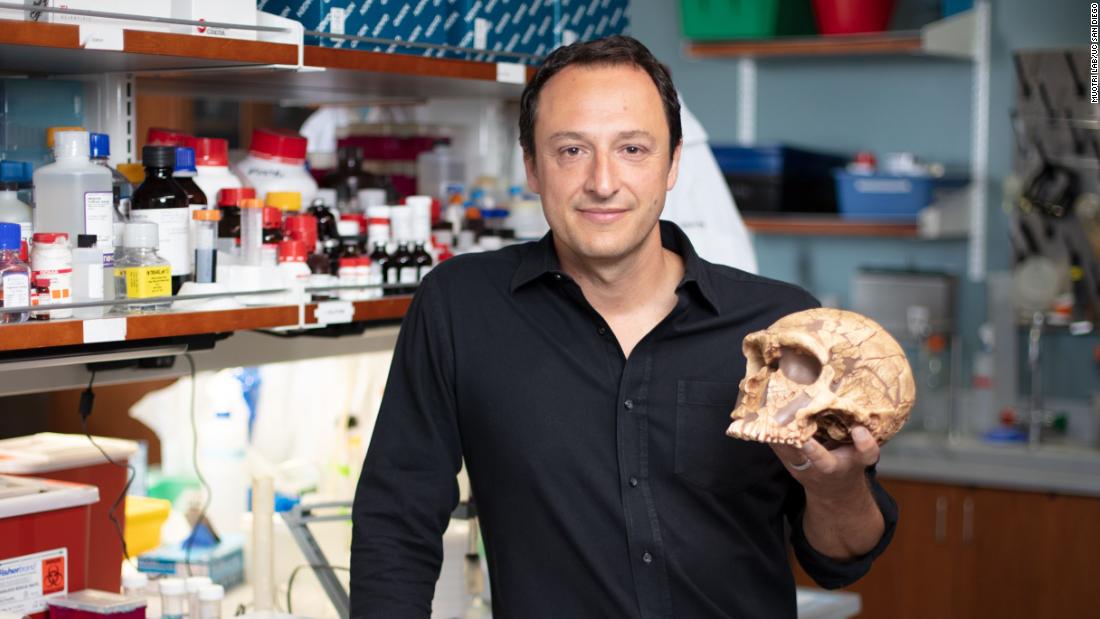
From the fossilized skulls we know that their brains were large (in fact a little larger than ours), but they tell us little about their neurology and development.
Scientists at the University of California at San Diego have found an exciting and provocative way to begin answering this question. They have created balls of genetically modified brain tissue to carry a gene that belonged to Neanderthals and other archaic hominins but not to Homo sapiens.
Although research is at a very early stage, the researchers found that Neanderthal brain organoids produced significant changes in the way the brain organizes and connects.
“The question here is what makes us human,” said Alysson Muotri, a professor and director of the stem cell program at the Institute of Genomic Medicine at the University of California School of Medicine in San Diego.
“Why are our brains so different from other species, including our own extinct relatives?”
Neuroarchaeology
Muotri, who has so far spent eight years on the project, describes his work as “neuroarchaeology”.
“When you find a piece of bone or (charcoal) and try to rebuild how that society lived, what they were doing, how they connected with each other, try to understand the mind. We’re doing the same thing in the genetic field. Level “.
Neanderthal brain organoids were a “popcorn shape” compared to the more rounded, uniform shape of modern humans, Muotri said. His team also observed that organoid neurons matured faster than modern humans.
“Neurons in the archaic version of organoids, we see more activity in the early stages than modern humans. We definitely didn’t expect that.”
He said he had observed similar activity in his previous work on chimpanzee organoids.
“A chimpanzee can far outnumber a human newborn. We need time to feed our babies until they are independent. We don’t see it in other species. I think what we’re seeing here is similar.”
However, Muotri stressed that this was speculative. Organoids are a long way from real brains. On the one hand, they lack connections with other organs.
“We don’t know how the human brain that carries these archaic versions will behave,” he said. “All these differences we see in the early stages could go away because the brain has ways to compensate.”
“But we know that subtle and early alterations in brain development can lead to consequences for the adult brain. We take, for example, the genes involved in autism.”
Gene edition with archaic material
We now know that many of us are a tiny part of Neanderthals, with DNA bearing traces of past encounters between early modern humans and Neanderthals, who populated Europe and parts of Asia until about 40,000 years ago.
The UCSD team first compared the genomes of Neanderthals, Denisovans, and modern human populations to locate which genetic variants were not shared with our close cousins.
“We asked what is unique about us? We end up with only 61 genes that encode proteins that are different between modern humans and archaic ones,” Muotri said.
The team chose to focus on a gene known as NOVA1 because it is considered a “master regulator” of other genes that affect early neurodevelopment in modern humans. Alterations in this gene have been linked to mental disorders such as schizophrenia and autism, he said.
The scientists then used CRISPR gene editing technology, which won the Nobel Prize in Chemistry in 2020, to change the modern NOVA1 gene to the archaic version of human stem cells and convinced the cells mother for them to grow into organoids.
“It’s an extremely difficult set of experiments,” said Grayson Camp, an assistant professor at the University of Basel in Switzerland, who did not participate in the research.
“Organoids are hard to control. If they had all the controls there, you might think that this unique amino acid change has a strong effect on brain development. Extraordinary thing.”
“No magical variant that makes us human”
This bold investigation naturally includes warnings.
Gene editing is not a perfect process and the insertion of an archaic gene into human cells does not reproduce what the Neanderthal genome was like, said Tony Capra, an associate professor of epidemiology and biostatistics at the Institute of Science. Bakar Computational Health from the University of California, San Francisco.
“It is a challenge to say that the organoid results of the Neanderthal variant necessarily reflect how Neanderthal brains developed,” he said by email. Capra did not participate in the study.
“This change is being evaluated in the context of the human genome, so the archaic variant is in a genetic background that does not reflect what the Neanderthal genome was like.”
Still, Capra was thrilled with the research, which was published Thursday in the journal Science. Still, he warned that “we shouldn’t expect there to be a magical variant that makes us human.
“Most of the traits that make us modern humans compared to Neanderthals (or even chimpanzees) are very genetically complex,” Capra said. “Thousands of parts of our genome contribute to neurodevelopment and cognition.”
He added: “Organoids are exciting because they allow us to test variants in more complex environments than individual cells, but ultimately we will have to ‘Neanderthalize’ the organoid completely.”
Recent archaeological discoveries have suggested that Neanderthals had many of the same cognitive abilities as early modern humans, but, like fossils and stone artifacts, neuroarchaeology is unlikely to be able to provide definitive answers, Capra said.
“We will never be able to recreate the environmental and social context in which these individuals lived or these events occurred. The environment is so essential to shaping the expression of genomes that we will always have to speculate,” he said.
“That said, I think we will learn a lot more from the bones and the genome over the next few years.”